The small area of this Milky Way has different forms of planetary systems, and the diversity far exceeds the expectations of astronomers
Author:The Chinese Academy of Science Time:2022.08.02
Produced: Gezhi Tao Dao Dao Dao Dao Tao
The following content is Yu Cong, a professor of the School of Physics and Astronomy of Sun Yat -sen University.
I am Yu Cong from Sun Yat -sen University, and I am mainly engaged in some astronomical studies. I am glad here today to introduce the outer planet.
This "system" refers to the solar system, so there will be a department in addition to the department. The planets in the solar system turned out to be the nine major planets, but astronomers found the farthest Pluto.
Outer planet
Completed: 10% ///////////
In fact, there are a lot of small celestial bodies similar to it. If Pluto is counted as planets, we will find that there are far more than eight planets in the solar system.

You can see that there are four inside on this picture, there are four on the outside, and the planets similar to the earth are dependent.
So, what is the situation outside the solar system?

This picture is the location of the solar system in the Milky Way. Everyone sees a yellow circle of yellow is the solar system where we are. Compared with the galaxy, it is really insignificant. We are a small solar system.
The Cairpler on the picture is a spatial telescope of the detection department. This yellow triangular area is the heavenly area observed. In fact, such a heavenly area is also small compared to the entire galaxy.
But in such a small area, astronomers found more than 4,000 planets in it.
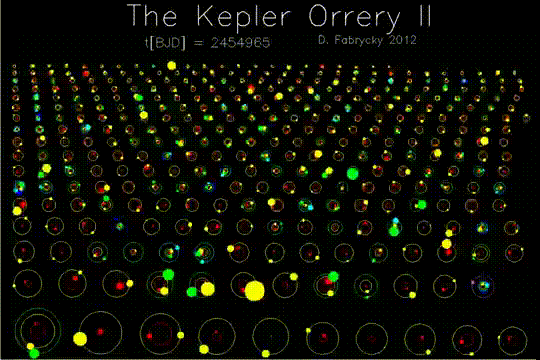
See a lot of rotating circles on this picture, this is the planet found by astronomers. You can see that this planet is different from the stars in the center, and the color is different. Different colors indicate that its temperature is also different.
Because the distance from the main star is different, the temperature on the surface will be different. Because the distance is different, the cycle of its exercise will be different. These are all planetary systems with different shapes. Their diversity far exceeds the expectations of astronomers.
With the help of space equipment, astronomers have made great progress in the field of external planets.

▲ 2019 Nobel Prize in Physics
The two scientists on the right side of the picture are some pioneers of some pioneers of foreign planets in 2019. Because they discovered the first outer planet similar to the sun star and won the 2019 Nobel Prize in Physics.
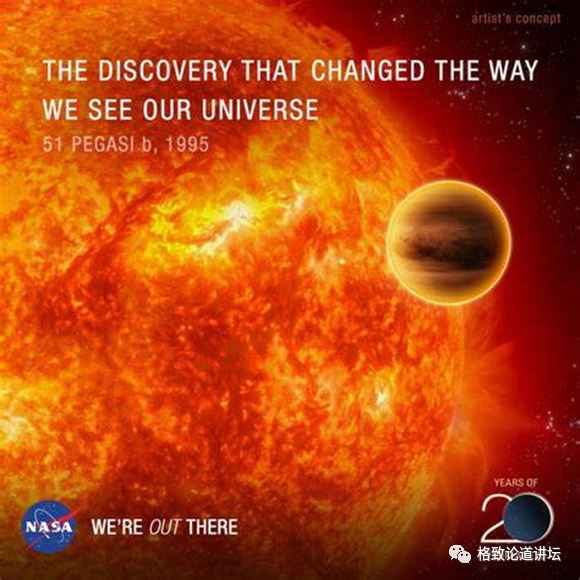
▲ Pegasus 51B: Wooden -like giant stars, not suitable for human living
Quality ~ 0.5 Jupiter Quality
Radius ~ 2 Jupiter radius
They discovered the Pegasus 51B. It was like the four of the solar system I just said, and it was a giant stars like Jupiter. This giant giant stars are not suitable for human residence. Its quality is probably half of the quality of Jupiter in our solar system.
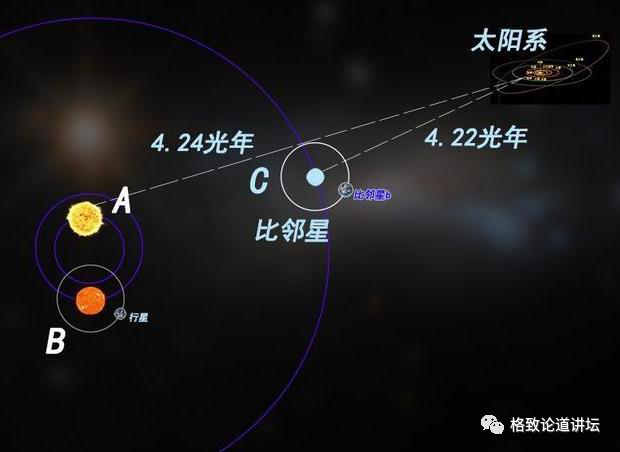
▲ Planet
Neighboring Star B ~ 4 Light Years
Size and the earth are similar
Cairple also found a kind of planet, a neighboring star from our nearest star, and a neighboring star B was found around the neighboring star.
It is about four years away from us. Its size is similar to the earth. It may also be in a livable zone. There may be liquid water. Such a planet is the goal of being particularly interested in research by astronomers.
The planetary goals are very small. What is the observation of astronomers? There are about two categories, one is a more indirect method, and the other is a relatively direct method.
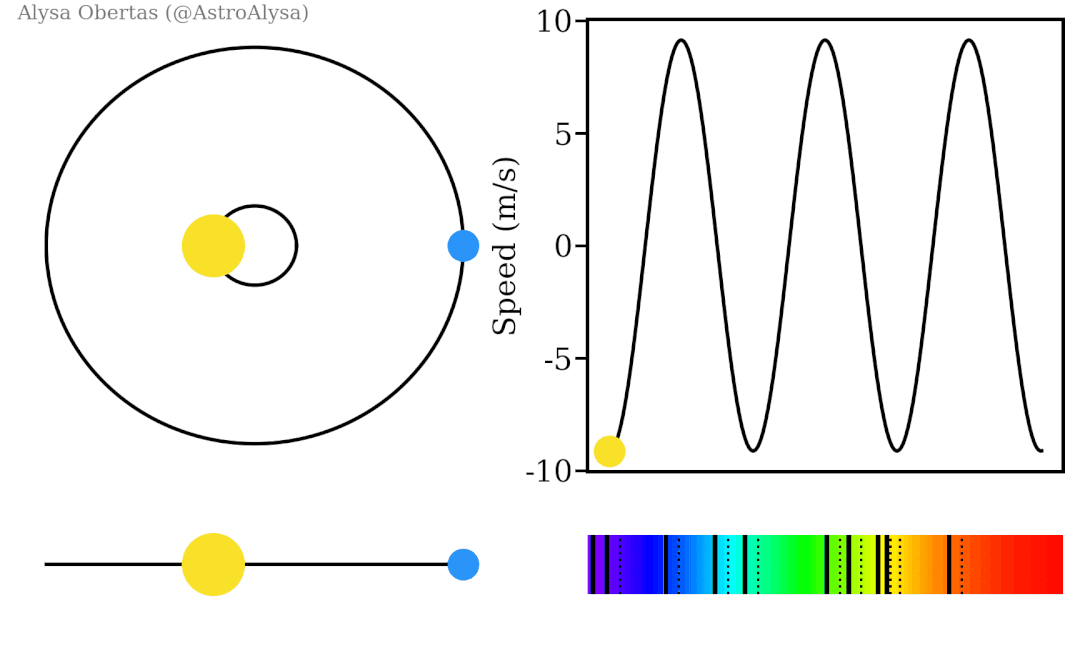
▲ Seeing speed: Doppler effect
The speed of the observer is negative, and the speed away from the observer is positive
The more indirect method is that the professional terms are called "looking at the speed". For example, when we wait for the train on the platform of the train station, the train screams. When it faces us, the whistling sound is getting higher and higher;
When leaving the platform, the tone of the train will be reduced, and the tone represents frequency and frequency changes can infer the speed of this train.
The layman star now is equivalent to a train on this planet. The blue dot on the picture is the planet, and the yellow dot is a star, because the stars and the planets around each other are equivalent to a train. It sometimes approaches us, sometimes stays away from us, and moves back and forth in this way.
During the movement, the sound of the train whistling like I just said, the sound of the tone becomes high and low. Now the research department is not the sound waves from the train, but the light waves from the stars.
Through this light wave, it also has frequency, which will also rise and decrease. By monitoring the rise and decline of this frequency, we can speculate on some information about the planet.
Everyone sees that this is an ideal schematic diagram like a mountain peak, and it is an ideal schematic. It will produce changes to the speed of view.
But in fact, astronomical observation is like this, everyone looks at the picture. Because astronomers also have to eat by the sky. If the weather is not good on the day, or if there is a cloud cover, we may not get the data point.
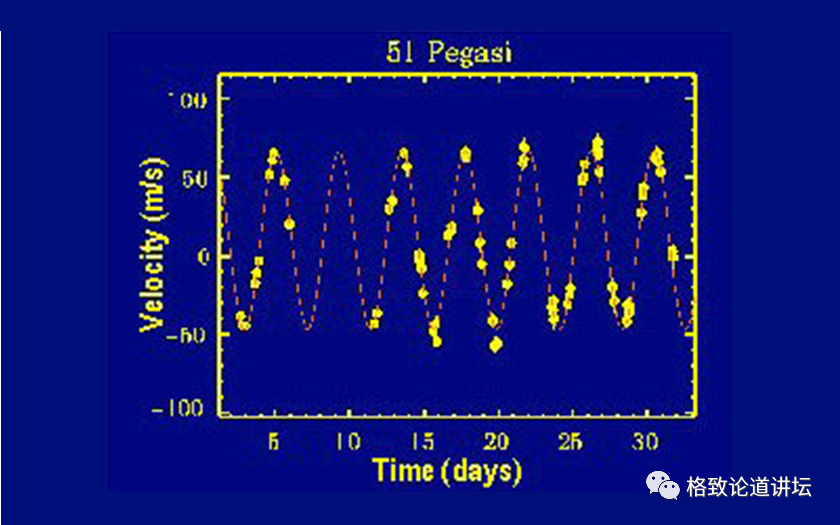
▲ Seeing speed: Doppler effect
By viewing the speed curve, it is speculated that the physical properties of the planet
The yellow point on the picture is some data points from astronomers get observation. If you slowly connect those points with curves, you can get a similar curve of the view of the same view.
We look at the speed of the planet by looking at the speed.
In addition to guessing the quality of the planet, this method can also get a very useful information, that is, the orbital inclination of the planet around the star.

▲ Planet's track inclination
The top line is that the stars are rotating, yellow represents stars, and stars are generally rotating. We know that the sun is also rotating, and the rotation is about 27 days. If it rotates, it will also produce the effect of a train similar to just now, because some of them are far from us and some are towards us.
Then, looking at the line in the middle, you can see that the red area is far away from us, the blue area is close to us, and there are blue and red to turn around, which will produce the effect of the train.
If this planet passes flat as flat as the first picture on the left, you can see that it blocks the blue part and the part that blocks the red is symmetrical;
In the middle of the second line, if it has an inclination, the planet blocks less part of the blue part, and the red part will become more; if the inclination angle is larger, such as the third picture of the third picture, it is completely completely full Without blocking the blue part, it only blocks the red part.
The bottom line of the bottom is corresponding to the speed of view. The leftmost part is symmetrical, the middle is not so symmetrical, and the far right is completely asymmetric. Astronomers can speculate on the orbital inclination of the planet based on the asymmetry, which is also a very important information about the formation of the planet.
Another method is that everyone may be familiar with the outer planet through Lingxing observation. For example, we often see news reports that are eclipse. This is because the moon is between the earth and the sun. The moon blocked the light of the sun. If it is more blocked, it becomes full food, and less blocking becomes partial.
▲ Lingxing Observation Department Outer Planet
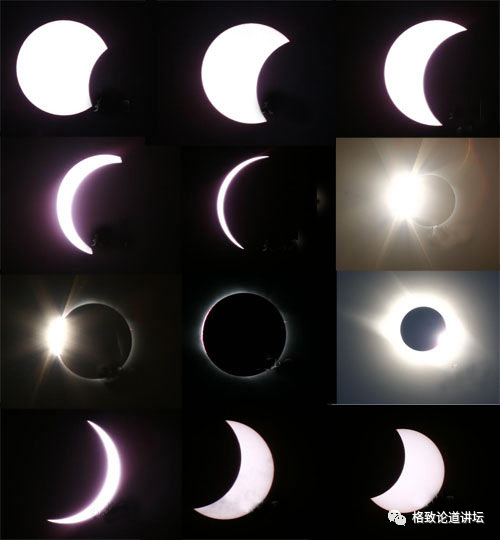
As shown in the figure, with the changes in time, the moon is bypassing the sun, and the height and brightness at the beginning are the relatively flat brightness line on the far left.
▲ Lingxing Observation Department Outer Planet
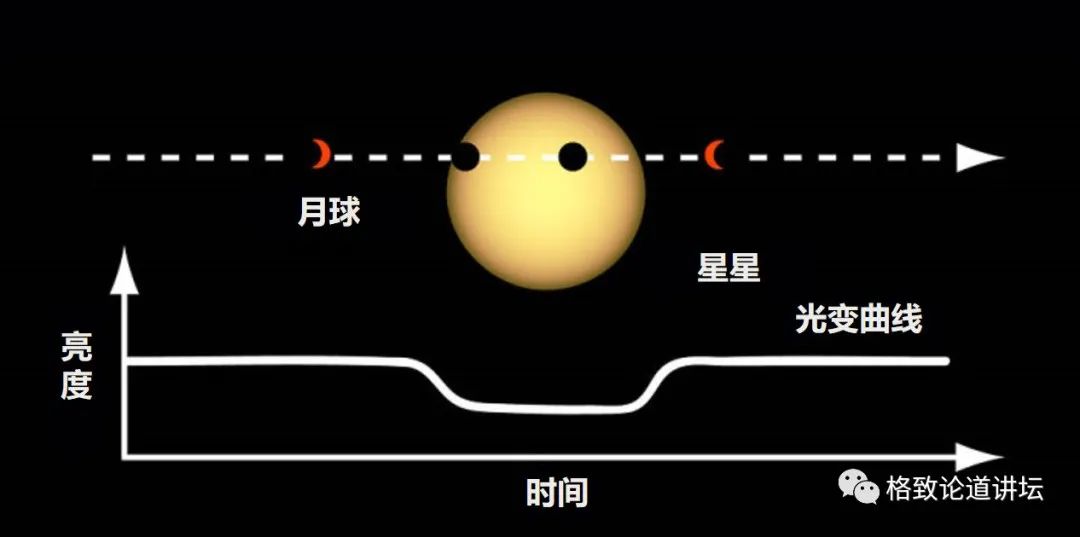
When it is blocked, it is equivalent to digging a pit underneath, and then the moon slowly walks out of the sun, and the brightness will rise again.
The planet can also play such a role.
You can watch this small movie. If the planet is between the stars and the earth, the planet blocks the stars around it, which will also cause changes in brightness and form a pit.
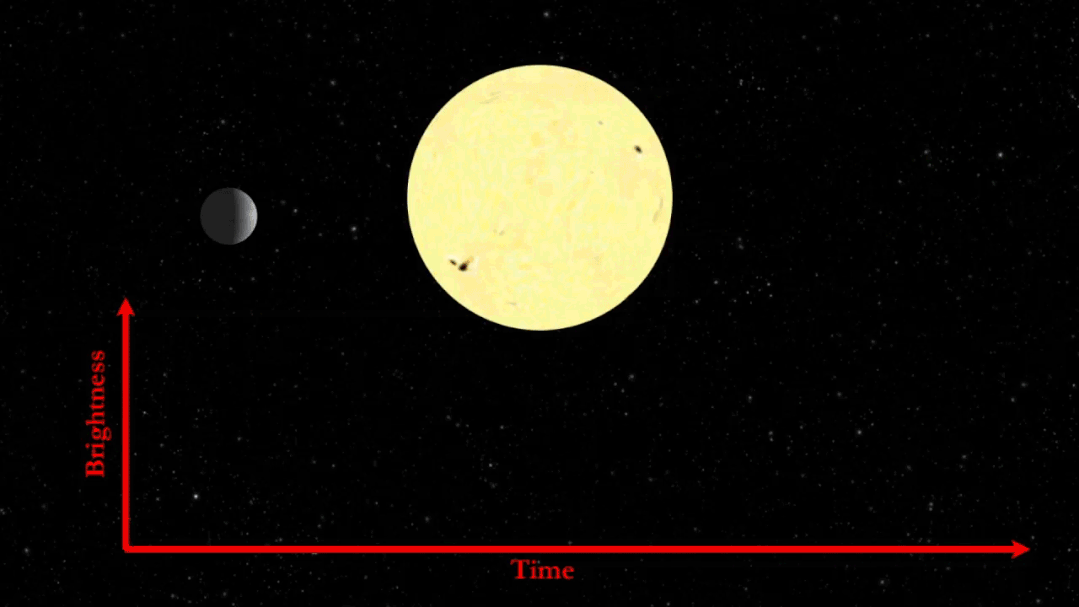
Through the signal of Ling Xing, we can speculate the size of this planet. If the planet is large enough, like the moon, it can become a whole food; if the planet is smaller, the pits that may be dug are relatively shallow, and the size of the planet is speculated by the depth of the pit.
Through Lingxing observation methods, we found many external planet systems.
One of them was particularly fun. We found 7 planets around us, and we called it "Gourd 7 Brothers". It has a significant difference from the solar system that is very dense, which is equivalent to 7 planets in the rails of Mercury in the solar system, and they are very densely arranged and the arrangement is relatively uniform.

This is the characteristic of many external planets that are different from the solar system, which is why we are fascinated by the research department.
The two just mentioned are indirect methods, of course, there are still very direct, such as direct imaging.
▲ Direct imaging

You can see that there are 4 stars in this picture. If you look closely, there are 4 highlights that are running around the middle of the middle. This is the four exogenous planets taken by the planet directly imaging.
There is a technical difficulty here, because turbulence will be encountered on the earth. If you take a plane, sometimes the flight attendant will remind us that the plane is bumping, that is, when we encounter turbulence, turbulence will cause oscillation.
If the telescope encounters turbulence in the air, this as if it will shake, and then it will not be clear. If this jitter is eliminated with appropriate technology, the analogy wears myopia glasses on myopia, and it feels that the world suddenly becomes clear.
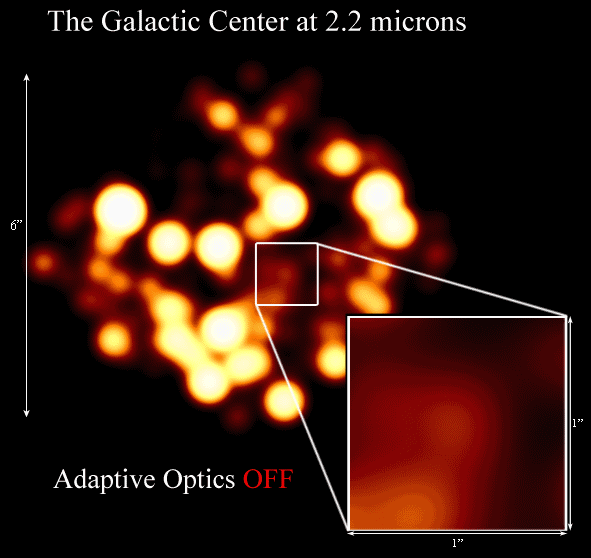
This diagram indicates that this technology can be used to obtain its direct imaging above the detection of the external planet on the left.
Of course, this is on the earth, and now we have also put the telescope on the sky. There is still a gap in our research level in China and international in this field, but we are also catching up.
▲ The exterior planet develops rapidly
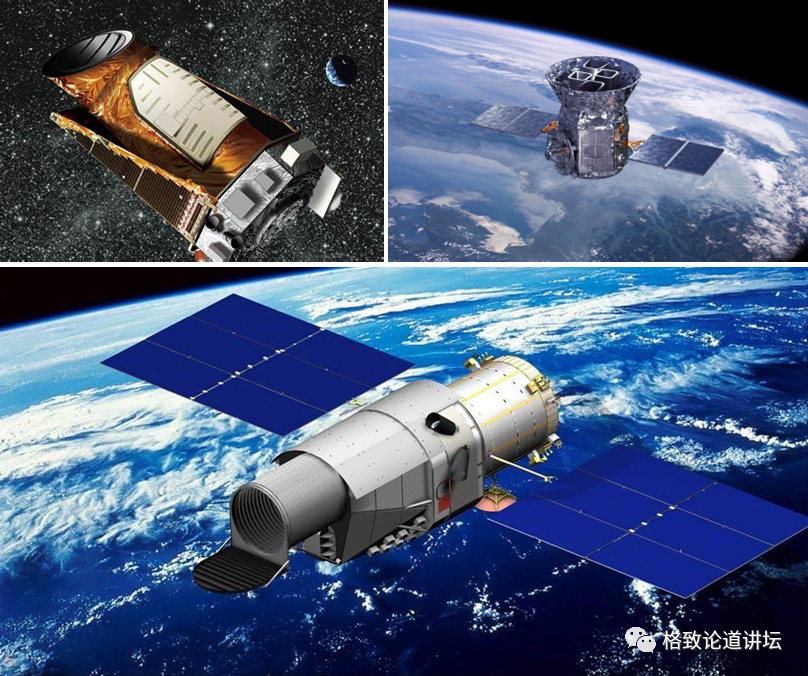
Upper left: Kepler Right: TESS Under: CSST
At the bottom, this picture is the sky -to -ended telescope of the Chinese space station project. Astronomers put a star crown in this telescope.
It can not only focus on the study of cosmic science, but also detect the atmosphere of the outer planet, which is equivalent to directly giving the atmosphere, and then detect some information in the atmosphere of the external planet.
For example, its chemical composition, its temperature distribution, etc., can also get the knowledge of many foreign planets. In the future, China's outer planet must also make great discoveries.
How is the outer planet formed?
Completed: 60% ///////////
We find so many ex -planets, everyone will be curious how this outer planet formed.
This flat structure is called a stagnation. You can see that the planets gathered and grew up slowly in this plate, and then disappeared slowly.
The planet is rotating around the central star to form a diverse planetary system we observe.
▲ Basic process of planet formation
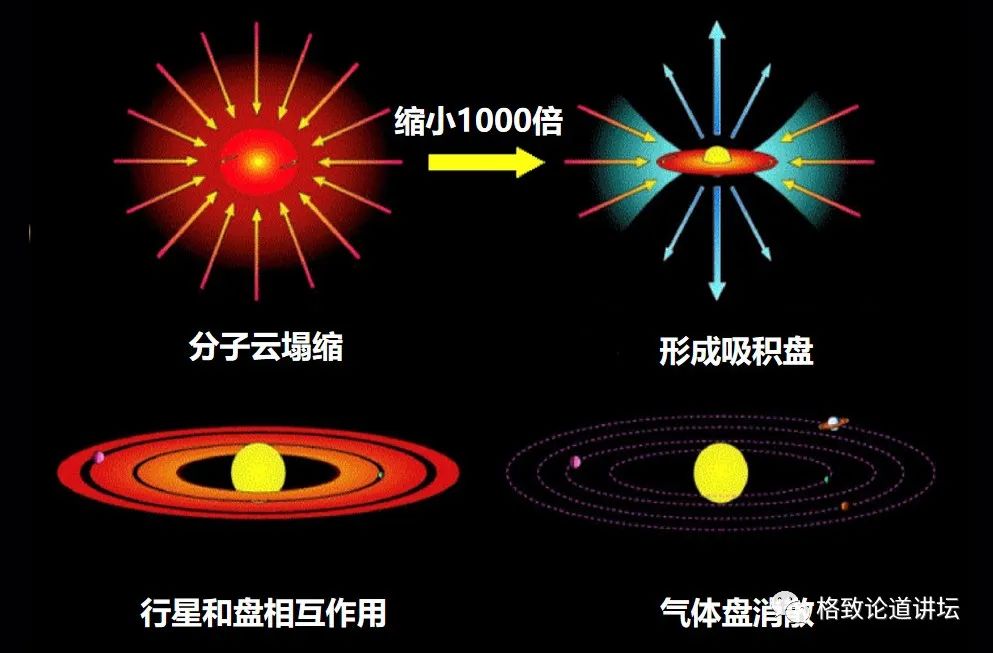
There are four very important steps for planet formation.
The first is the collapse of the molecular cloud, after the collapse, such as shrinking a thousand times, and then forming a stagnation. The interaction between the accumulation plate and the planet, this disk slowly disappeared, leaving only the planet rotating the stars in the middle. In the first step to the second step, the volume shrinkage will occur in this, and there is a new term called "angle volume".
If you have seen figure skating athletes, you should understand that at the beginning of the beginning, the figure skaters opened their hands and rotated very slowly. When he gathers, he will rotate quickly, which shows that the angle momentum is conservative.
When it is gathered, it is equivalent to the first graphic molecule cloud collapse and the collapse, the angular speed will increase, just like the chef throwing the Indian flying cake, it will throw out a cake -shaped structure, which is astronomy, that is, astronomy, which is astronomy. The suction disk is what the family refers to.
This accumulation disk has an important role in forming the planet. With this disk, there are about two channels that can form planets, which depends on the quality of this accumulation.
The first passage is to be the quality of this accumulation, because the gravitational unstable in the large -quality accumulation disk is unstable.
For gravity, it is equivalent to Newton's found that Apple landed, because the two objects will attract each other, and the large -quality accumulation will form a large -quality planet. You can watch this small movie.
This accumulation disk will rotate when forming. You can see a structure -like structure, and then these s collide with each other, the most center form a very bright star.
In the periphery, everyone will have two very bright spots. The first one appears, and now the second one appears. These two spots are formed a large -quality planet.
The second passage is that if the quality of the accumulation is relatively small, the gravity is unstable.
You can take a look at this small quality. Seeing it is just turning there, and there is no kind of small spots that just mentioned, but a star formed in the middle, and there is no surrounding planet.
On this channel, dust plays a very important role.
▲ Dust → Xingzi → Planet embryo
In this channel, there are not only gas and dust in the plate. The dust is like PM2.5, which we usually call PM2.5, very small particles, colliding with each other, sticking together, and gradually growing up.
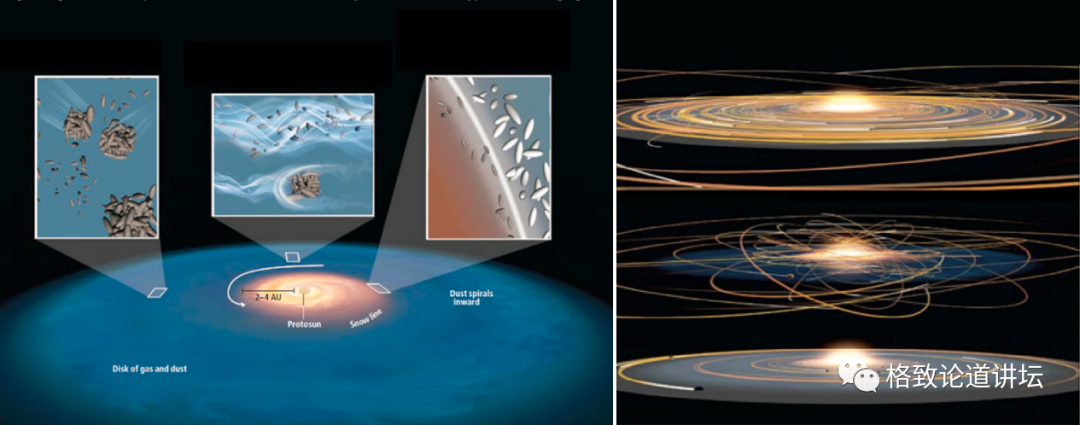
After growing up, it becomes a star. This star may become huge rocks and reaches the size of the kilometer. It is a large stone of one kilometer -sized. In the early stage of the planet, there will be such a large number of items.
When these kilometers of stones fly around the stars, they will also collide with each other and attract each other. They will grow larger, and they will form planet embryos. Individuals are estimated to be like the lunar size.
There is also a more interesting thing, if the gravity is dominant, it is very strong. At this time, the planet embryo will interact with this accumulation disk. Here you can see the animation. The planet embryo is equivalent to a stone thrown into a pool.
You can see that the stone is equivalent to the brightest point in the middle. The stone will stir up a ripple in the orange pool. This is the effect of the planet embryo and the interaction of this disk.
In addition to ripples, the planets will move towards the central star. You can see this picture. The planets are not only rotating around the stars, but they are constantly spinning when they rotate.
The theory shows that the rotation speed is very fast. Without any mechanism to hinder its rapid migration, we generally cannot see the planet, and it will be swallowed by the surrounding stars.
Vortex instability
Completed: 90% ///////////
We have also done a little thing, that is, to take a way to slow down its migration. This is the instability of the vortex.
If you have experience in your life, such as the structure in a plate is not so smooth, such as a stone suddenly stands in a water flow, and there will be some small vortex behind the stone.
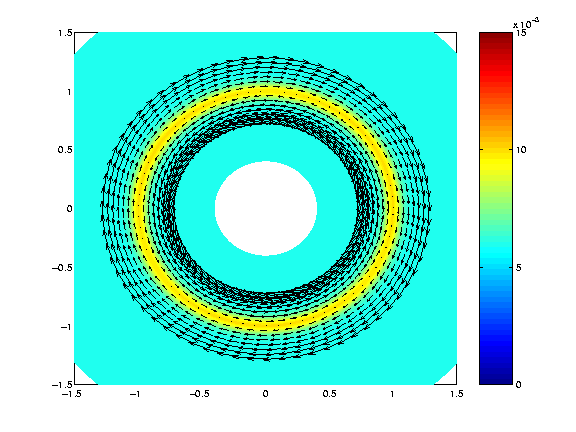
There are similar situations in the accumulation disk, which will also lead to the emergence of the vortex. It may greatly slow down the speed of the planet's inwardness. We have the opportunity to see the surviving planets in this disk.
In addition to the planet, this stone stirred ripples in the pool, and it can also suck the surrounding gas.
At the beginning, when the eight major planets were said, there were solid planets like giant stars and land -like planets.
During the formation of the planet, if it has the ability to suck this gas to the surroundings and suck sufficient amount, it may grow into a giant star, like wood -like planets; The gas completely disappeared when it sucks, and there is nothing to suck, then it will become planets like the earth.

The above is the question of how the planetary system is formed and how to observe. But in fact, there are many unsolved puzzles in it. If my report can attract more young people's attention, the purpose of my report will be achieved.
thank you all!

"Ge Zhi Tao", originally called "Self,", is a scientific and cultural forum launched by the Chinese Academy of Sciences. It is co -sponsored by the Computer Network Information Center of the Chinese Academy of Sciences and the Science Communication Bureau of the Chinese Academy of Sciences. Cross -border communication is dedicated to extraordinary thoughts, and it aims to discuss the development of science and technology, education, life, and future development with the spirit of "knowledge to know". Get more information. This article is produced from the "SelfTalks) of the" Gezhi Tao Tao ". Please indicate the source of the public account for reprinting.
- END -
11 people!Hebi, a state -owned enterprise, intends to openly recruit staff for the society

July 11Hebi Agricultural Reclamation Group Co., Ltd.Publish a recruitment announce...
Lu Linxin joins hands with rejuvenation -2022 Rugu Consumption Assistance Exhibition Fair launched today

Babao Gai bowl tea, fresh beef and mutton, sweet and sour beer special fruit, Shan...